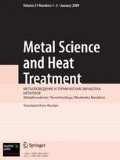A module supplementing the ABAQUS software is developed for solving a joint heat and diffusion problem with allowance for the phase transformations in materials in the process of induction quenching. The approach provides a deeper study of the structure and properties of materials and makes it possible to develop a method for computing the number of phase components, the size of austenite grains, the hardness, the thermophysical characteristics, and the latent heat of induction quenching. Such computations are impossible on the basis of standard softwares. The adequacy of the simulation tool suggested by the authors is confirmed by matching between simulated and experimental data.







Similar content being viewed by others
References
M. Kchaou, D. Durand, and F. Dammak, “Superficial quenching of mechanical pieces and calculation of residual stresses: modeling and simulation,” Metal Sci. Heat Treat., 52(3 – 4) (2010).
M. Kchaou, M. Yaakoubi, and F. Dammak, “Effect of the superficial hardening on distortion and stress state: application on bearing race,” Int. Rev. Mechan. Eng., 3(4), July (2009).
Caner Simsir and Cemil Hakan Gur, “A mathematical framework for simulation of thermal processing of materials: application to steel quenching,” Turkish J. Eng. Env. Sci., 132, 85 – 100 (2008).
R. C. Dykhuizen, C. V. Robino, and G. A. Knorovsky, “A method for extracting phase change kinetics from dilatation for multistep transformations: austenitisation of low carbon steel,” Metall. Mater. Trans. B, 30B, 107 (1999).
M. Elfenne, “Etude thermique et métallurgique de la couche trempée par pulvérisation d’eau aprés chauffage superficiel par induction d’un acier XC42,” in: Thesis INPL, Nancy (1985), p. 105.
J.W. Christian, The Theory of Phase Transformations in Metals and Alloys. Part 1, Pergamon Press, New York (1981), pp. 525 – 548.
J. Orlich, “Les processus d’austenitisation au cours de l’échauffement rapide et l’échauffement par impulsion de l’acier,” Traitement Thermique, 90, 69 – 75 (1974).
Caner Simsir and C. Hakan Gur, “3D FEM simulation of steel quenching and investigation of the effect of asymmetric geometry on residual stress distribution,” J. Mater. Proc. Technol., 207, 211, 221 (2008).
A. M. Habraken and M. Bourdouxhe, “Coupled thermo-mechanical-metallurgical analysis during cooling process of steel pieces,” Eur. J. Mechan. A. Solids, 11(3), 381 – 402 (1992).
W. P. Oleivera, M. A. Savi, P. M. C. L. Pacheco, and L. F. G. Souza, “Thermo mechanical analysis of steel cylinders quenching using a constitutive model with diffusional and non-diffusional phase transformations,” Mechan. Mater., 42, 31 – 43 (2010).
D. P. Koistinen and R. E. Marburguer, “A general equation prescribing extent of the austenite-martensite transformation in pure Fe – C alloys and plain carbon steels,” Acta Metall., 7, 59 – 60 (1959).
“ABAQUS documentation,” in: ABAQUS Analysis User’s Manual.
D. Farias, S. Denis, and A. Simon, “Les transformations de phases en cycle thermique rapide et leur modélisation. Cas d’un acier XC42,” Traitement Thermique, 237, 63 – 70 (1990).
F. M. B. Fernandes, “Modélisation et calcul de l’évolution de la température et de la microstructure au cours du refroidissement continu des aciers,” in: Thesis INPL, Nancy (1985), p. 177.
M. Melander, “A computational and experimental investigation of induction and laser hardening,” in: Thesis Linkoping, Suede (1985), p. 124.
W. I. Pumphrey and F.W. Jones, “Inter-relation of hardenability and isothermal transformations,” Data JISI, 159, 137 – 144 (1948).
J. B. Leblond and J. Devaux, “A new kinetic model for anisothermal metallurgical transformations in steels including effect of austenite grain size,” Acta Metall., 32(1), 137 – 146 (1984).
S. J. Lee and Y. K. Lee, “Effect of austenite grain size on martensitic transformation of a low alloy steel,” Mater. Sci. Forum, 475 – 479, 3169 – 3172 (2005).
Jiang Yue, Yin Zhong-da, Kang Peng-chao, and Liu Yong, “Fuzzy modeling of prediction of M s temperature for martensitic stainless steel,” J.Wuhan Univ. of Technol., Mater. Sci. Ed., 19(4) (2004).
M. Umemoto and J. A. Feeney, “Effect of austenitizing temperature and austenite grain size on the formation of a thermal martensite in an iron-nickel-carbon alloy,” Metall. Trans. A, 5A, September, 2041 – 2046 (1974).
D. Mercier, X. Decoopman, and D. Chicot, “Model to determine the depth of a diffusion layer by normal indentations to the surface,” Surf. Coat. Technol., 202, 3419 – 3426 (2008).
B. Smoljian, S. S. Hanza, N. Tomašić, and D. Iljkić, “Computer simulation of microstructure transformation in heat treatment processes,” J. Achiev. Mater. Manuf. Eng., 24, 275 – 282 (2007).
Author information
Authors and Affiliations
Corresponding author
Additional information
Translated from Metallovedenie i Termicheskaya Obrabotka Metallov, No. 7, pp. 41 – 48, July, 2013.
Rights and permissions
About this article
Cite this article
Yaakoubi, M., Kchaou, M. & Dammak, F. Simulation of Heat Treatment and Materials with the Use of the Abaqus Software. Met Sci Heat Treat 55, 386–392 (2013). https://doi.org/10.1007/s11041-013-9641-5
Published:
Issue Date:
DOI: https://doi.org/10.1007/s11041-013-9641-5




